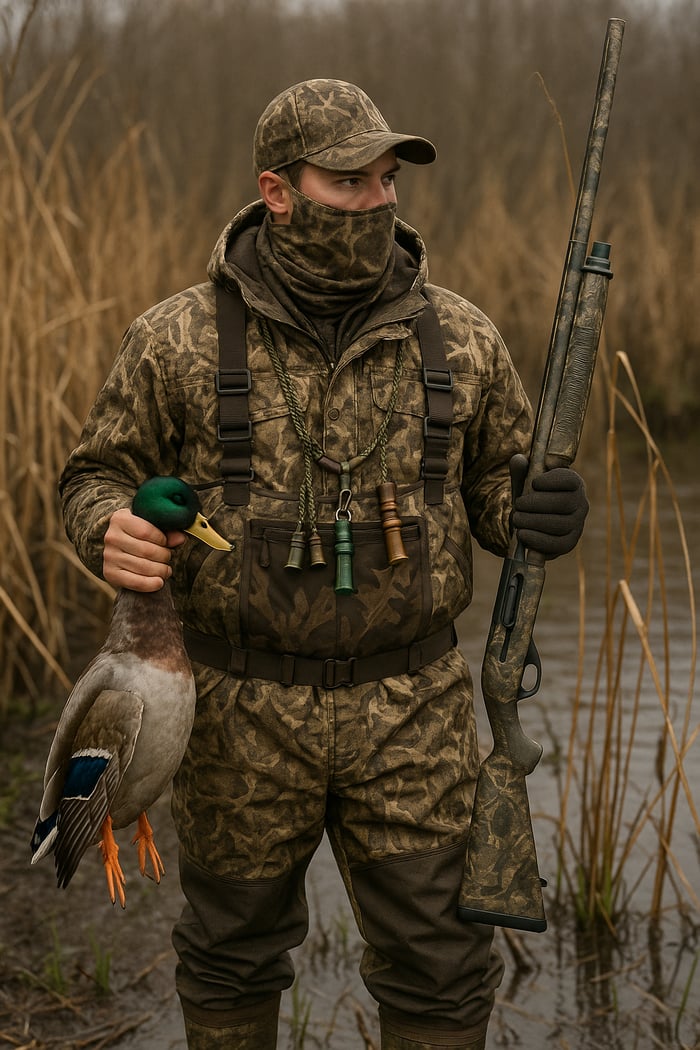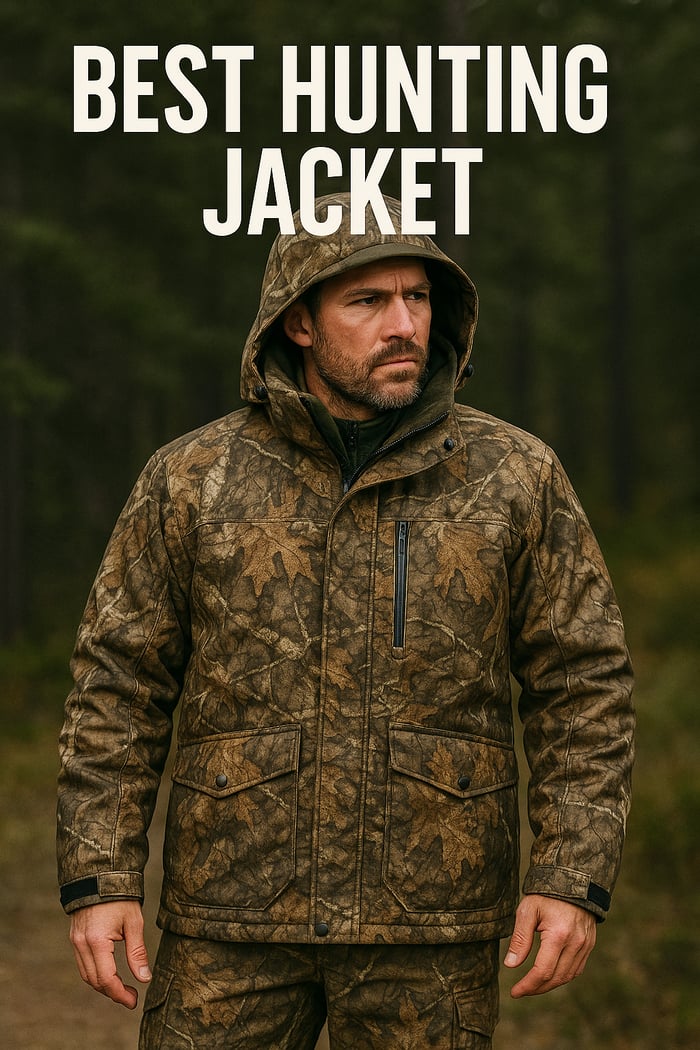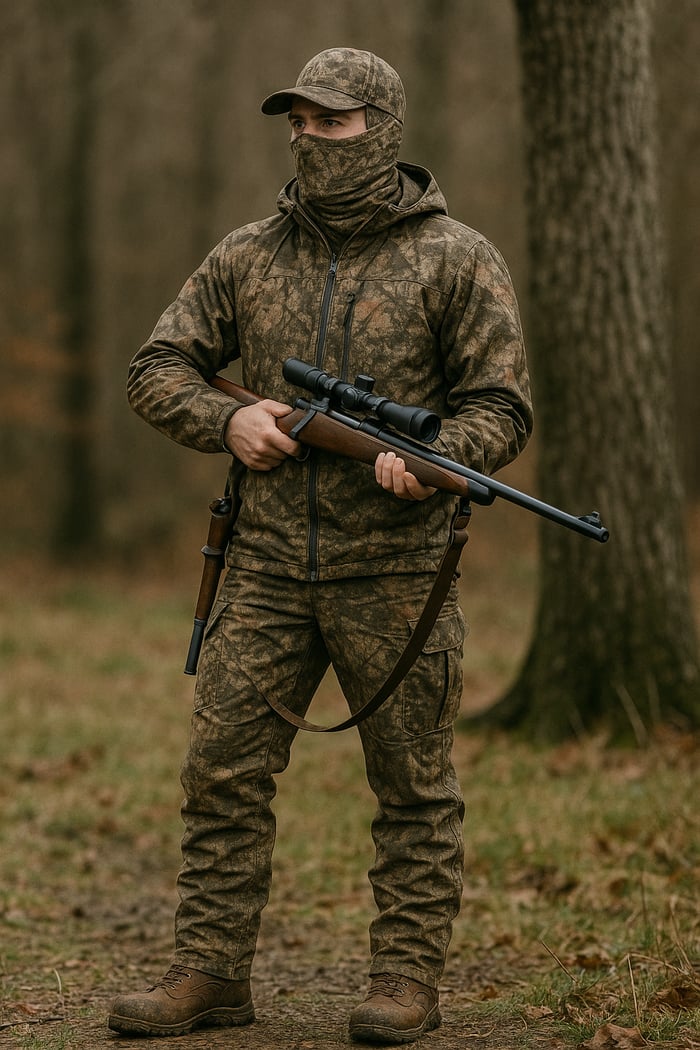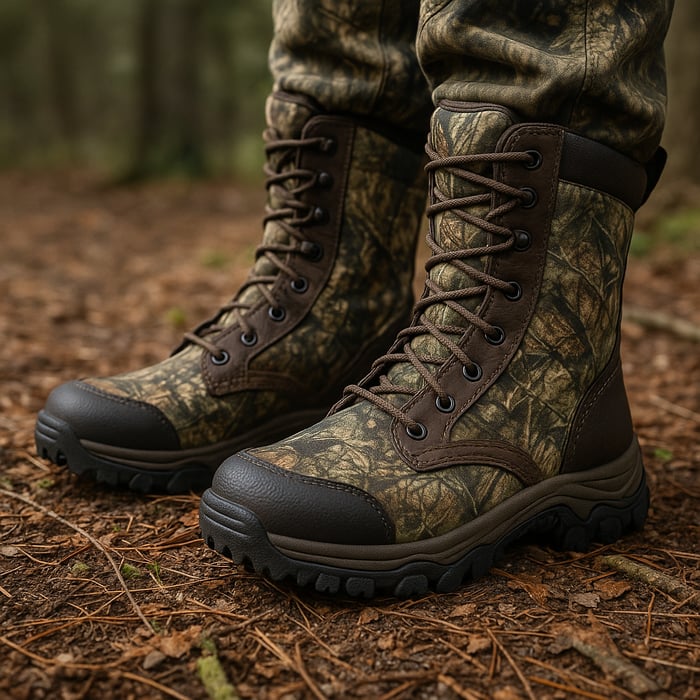Duck hunting is an exhilarating outdoor experience that involves skill, patience, and an intimate sense of nature. Whether wading through frozen marshes or concealed in a blind at dawn, the right duck hunting equipment can make or ruin your adventure. From waders to shotguns, decoys to camouflage, every item of duck hunting equipment plays a crucial role in assisting you in blending with the surroundings, remaining comfortable, and bagging your limit. In this in-depth 3000-word tutorial, we shall discuss everything about duck hunting gear that you'll ever need to know, ranging from what to look for and how to find the best possible options to what tips and advice you can implement to get maximum value out of your gear. Let's get into the world of duck hunting equipment and get you ready for a productive season.
Why Investing in Quality Duck Hunting Gear Is Important
Duck hunting is not like other hunting. The conditions—wetlands, rivers, and flooded timber—are demanding, and the weather can be brutal. Ducks are also famously cautious, with keen eyesight and acute hearing that make them hard to deceive. That's where duck hunting equipment comes into play. Good equipment keeps you warm, dry, and camouflaged, and assists in attracting ducks and making clean, ethical shots.
Without the right duck hunting equipment, you could end up shivering in wet clothes, fighting with a broken call, or seeing ducks spread because your camouflage didn't match. Good-quality duck hunting equipment is worth the investment in your comfort level, your safety, and your success. It's made to endure mud, water, and cold and to assist you in outwitting one of nature's most wary animals.
What to Look for in Duck Hunting Gear
When selecting duck hunting equipment, pay attention to these important attributes:
Durability: Wetlands are harsh on gear, so your gear must be able to survive mud, water, and abuse.
Camouflage: Ducks have excellent eyesight and can detect even the slightest imperfection, so your duck hunting equipment must blend seamlessly into your hunting cover.
Comfort: All-day wear in the field requires gear that is comfortable to sit in a blind or wade through water.
Weather Resistance: Waterproof and insulated duck hunting equipment is necessary for staying warm and dry in wet, cold environments.
Portability: You will frequently have to carry your duck hunting equipment long distances, so lightweight and packable is a huge advantage.
With these considerations in mind, let's dissect the necessary components of duck hunting equipment every hunter should have, from head to toe.
The Essential Duck Hunting Equipment Checklist
1. Waders: Your Comfort and Protection Foundation
When you're up to your knees in a marsh or wading through a flooded field, waders are the foundation of your duck hunting equipment. They keep you dry, toasty, and safe from the elements so you can concentrate on the hunt rather than your misery.
Types of Waders in Duck Hunting Equipment
There are two main types of waders to look for in your duck hunting equipment:
Chest Waders: These reach up to your chest, providing maximum protection and coverage. They're best for deep water, cold conditions, or when you need to remain dry from head to toe.
Hip Waders: These reach up to the hips and are more suitable for shallow water or warmer conditions. They're lighter and more mobile but provide less protection.
Waders come in a variety of materials, with neoprene and breathable fabrics being the most popular. Neoprene waders provide excellent insulation for cold-weather hunts, while breathable waders are lighter and more comfortable in milder conditions. Look for waders with reinforced knees, sturdy boots, and a camouflage pattern that matches your hunting environment.
How to Choose the Best Waders
Fit: Waders must fit tight but not constricting. Wear them with your hunting attire to check for a proper fit.
Insulation: For winter hunts, select waders with 3-5mm neoprene or insulated built-in. For warmer hunts, use breathable waders.
Durability: Look for reinforced stitching and puncture-resistant fabric.
Accessories: A wader repair kit is an indispensable part of your duck hunting equipment for repairing leaks in the field.
2. Camouflage Clothing: Merging with the Surroundings
Ducks possess amazing eyesight, and therefore camouflage clothing is an essential component of your duck hunting equipment. Each item of clothing, from your jacket to your gloves, must make you blend into your environment.
Selecting the Right Camouflage Pattern
The ideal camouflage pattern will vary based on where you hunt. Some of the most popular camouflage patterns for duck hunting equipment include:
Marsh and Wetland Hunting: Blacks such as Realtree Max-5 or Mossy Oak Bottomland mix easily with reeds, cattails, and murky water.
Timber Hunting: Darker blacks such as Mossy Oak Shadow Grass or Realtree Timber are best for woodlands.
Open Fields: Blacks such as Realtree Edge or Sitka Waterfowl Marsh perform well in grasslands or farm backgrounds.
Your duck hunting gear should include a camouflage jacket, pants, gloves, hat, and face mask. Layering is essential for staying comfortable in changing weather. Start with moisture-wicking base layers, add insulating mid-layers like fleece, and top it off with a waterproof, windproof outer layer.
Tips for Effective Camouflage
Avoid shiny fabrics or gear with reflective surfaces, as even a small glimmer can spook ducks.
Use camo face paint or a face mask to camouflage exposed skin.
Wash your camouflage gear with odorless detergent to prevent alerting ducks with abnormal scents.
3. Duck Calls: The Art of Attraction
A duck call is perhaps the most recognizable bit of duck hunting equipment. It's your method of communicating with ducks, replicating their voices in order to bring them within shooting range. Utilizing a duck call effectively requires practice and sensitivity.
Types of Duck Calls
Single-Reed Calls: These are more adaptable and can be used to make a variety of sounds, from soft quacks to loud hail calls. They take more practice to master but provide more control.
Double-Reed Calls: These are simpler for new callers to use and have a raspier, more natural sound. They're less adaptable but perfect for close-in hunting.
Duck calls are available in various materials with their own tone. Acrylic calls are strong and loud and are suitable for open water, while wooden calls have softer and milder tones for timber or close-up hunting.
How to Use a Duck Call
It takes practice to learn to call a duck. Learn simple quacks and progress to more sophisticated calls such as feeding chatter or come-back calls. hunters often carry several calls as part of their duck hunting equipment to call different species of ducks or adapt to varying situations.
Pro Tip
Practice calling at home or during the off-season so you build confidence. You can also listen to actual duck calls so you can adjust your technique. A badly blown call can drive ducks away, so it's well worth taking the time to do it properly.
4. Decoys: Creating a Convincing Spread
Decoys are an essential component of your duck hunting equipment, providing the illusion of a secure, welcoming spot for ducks to alight. A strategically placed decoy spread can attract ducks from afar and hold them close enough for a clean shot.
Types of Decoys
Floating Decoys: They are the most popular and applied in shallow water or open lake. They have a range of species, such as mallards, pintails, and teal.
Motion Decoys: They introduce motion to your spread, such as spinning wings or swimming decoys, to lure ducks from distances.
Silhouette Decoys: Light to carry and lightweight, they are ideal for field hunting or in situations where speed is required.
When setting up your decoys, aim for a natural-looking spread. Place them in small groups with plenty of landing space, and mix different species to mimic a real flock. A decoy bag is a handy addition to your duck hunting gear for easy transport and storage.
Decoy Setup Tips
Use a jerk string to add subtle movement to your spread, mimicking ducks swimming or feeding.
Clean your decoys on a regular basis to strip away mud and avoid unnatural shine.
Try various spreads, such as a J-hook or U-shape, to determine what works best in your hunting location.
5. Shotguns and Ammunition: The Heart of the Hunt
Your shotgun is the focal point of your duck hunting equipment, and selecting the right one is essential to making clean, ethical shots. The ammunition you use with it is equally important.
Selecting a Shotgun
Most hunters of ducks use 12-gauge shotguns because they are powerful and versatile. Some of the most popular shotguns are Remington 870, Benelli Super Black Eagle, and Browning A5. Opt for a shotgun with a barrel of 26 to 28 inches and a synthetic stock to ensure durability in rainy weather.
Ammunition
Because of the ban on lead shot in waterfowl hunting, steel shot is the norm for duck hunting. Opt for 2¾- or 3-inch shells loaded with shot sizes #2 through #4 for maximum range and stopping power. For better performance, some hunters load with tungsten or bismuth shot, which are heavier and strike harder than steel.
Shotgun Accessories
Include these in your duck hunting equipment to improve the performance of your shotgun:
Choke Tubes: Improved or altered cylinder chokes are best suited for most duck hunting situations.
Sling: Conveniently carries your shotgun over long distances.
Cleaning Kit: Maintains your shotgun in good working order, particularly after getting wet and muddy.
6. Hunting Blinds: Being Hidden and Comfortable
Duck hunting blind is necessary duck hunting equipment for remaining hidden from keen-eyed ducks. When you're in a marsh, field, or forest, a blind keeps you concealed yet safe from the elements.
Types of Blinds
Types of blinds used in duck hunting range from simple layout blinds to ones that are permanently mounted.
Layout Blinds: Field blinds that are low profile. These are lightweight and easy to deploy.
Boat linds: Designed for boat hunting, these blinds offer cover when you're afloat on the water.
Permanent Blinds: Made to fit particular spots, usually on private property, these are more comfortable but less portable.
Pop-Up Blinds: Light and convenient to install, these are ideal for hunters who shift locations.
When selecting a blind, select one that is simple to install, blends in with your hunting terrain, and provides sufficient space for you and your duck hunting equipment. Several hunters incorporate natural cover, such as grass, cattails, or limbs, into their blinds for added camouflage.
Blind Tips
Install your blind early to prevent spooking ducks while they approach.
Maintain your blind free of shiny items that may reflect light
Use a blind bag to organize your duck hunting gear and keep it within reach.
7. Accessories: The Small Details That Make a Big Difference
In addition to the major pieces of duck hunting gear, a range of accessories can make your hunt smoother, safer, and more enjoyable. Here are some must-haves to include in your duck hunting gear collection:
Essential Accessories
Hunting Backpack: For transporting equipment to and from the field. Choose a waterproof or water-resistant option.
Headlamp: Useful for pre-dawn setups or hunting in poor light.
Thermos: Warms coffee, soup, or hot chocolate through on long, cold hunts.
First-Aid Kit: A safety necessity for minor injuries.
Game Strap: For carrying shot ducks back to your truck.
Binoculars: Assist you in spotting ducks from afar and planning your approach.
Tech Gadgets
Contemporary duck hunting equipment may also have technology to help you gain an advantage. An app such as HuntWise or OnX can assist in scouting hunting areas, monitoring weather patterns, and marking successful locations. A GPS unit is also a wonderful addition to your duck hunting equipment so that you won't get lost in new terrain.
8. Dog Gear: Outfitting Your Hunting Buddy
If you hunt with a retriever, your retriever is an integral member of your team, and they should have their own duck hunting equipment to be safe and function best.
Basic Dog Equipment
These are the bare essentials your retriever needs.
Dog Vest: A neoprene vest will keep your dog warm and safe from scratching reeds or cold water.
Collar: A highly visible, reflective collar will be easier to find your dog in low light conditions.
Leash: For keeping your dog under control before and after the hunt.
Training Whistle: Helps you communicate with your dog in the field
Make sure your dog’s duck hunting gear is comfortable and fits properly. A well-equipped retriever can make a huge difference in recovering downed ducks and making your hunt more efficient.
How to Choose Duck Hunting Gear on a Budget
Quality duck hunting equipment is pricey, but there is no need to break the bank to begin. These are some guidelines on how to accumulate duck hunting equipment without emptying your wallet:
Prioritize Essentials: Begin with the fundamentals—waders, a shotgun, some decoys, and a duck call. You can incrementally add additional duck hunting equipment as finances permit.
Buy Used: Browse local hunting stores, online auction sites, or hunting forums for lightly used equipment.
Shop Sales: Check for off-season discounts or near holiday seasons such as Black Friday.
Invest in Durability: Shelling out a little extra at the beginning to invest in durable duck hunting equipment will pay dividends down the line by minimizing the need for replacement.
Maintaining Your Duck Hunting Gear for Longevity
Maintenance is essential for getting the maximum value from your duck hunting equipment. Here's how to ensure your gear stays in tip-top condition:
Waders: After each hunt, clean mud and debris from them. Keep them in a cool, dry environment, and test for leaks routinely. For tiny holes, apply a wader repair kit to patch them up.
Clothing: Wash camouflage clothing with scent-free detergent to prevent scaring ducks. Store in a dry area to prevent mildew.
Decoys: Clean decoys to prevent mud and cracking. Store in a decoy bag to keep them safe from damage.
Shotgun: Clean and oil your shotgun after each hunt to prevent rust and smooth operation.
Calls: Store duck calls in a protective case to prevent damage to the reeds or body.
Blinds: Check your blind for tears or frayed areas, and keep it in a dry location to avoid mold.
Maintenance not only lengthens the lifespan of your duck hunting equipment but also guarantees it works when you need it.
Common Mistakes to Avoid with Duck Hunting Gear
Even veteran hunters can fall into traps with duck hunting equipment. Here are some common errors to avoid:
Skimping on Quality: Bargain gear tends to break down in the field, leaving you cold, wet, or irritated. Spend money on quality duck hunting gear that will hold up.
Ignoring Fit: Poorly fitting waders or clothing can be uncomfortable and restrict your movement. Take the time to find well-fitting gear.
Overloading: Duck hunting equipment weighed down by excess gear can be cumbersome and complicate movement on difficult terrain. Take only essential items.
Neglecting Camouflage: Failure to blanket shiny surfaces, improper camo pattern wear, or exposing unprotected skin can shock ducks.
Skipping Maintenance: Inadequate cleaning or upkeep of duck hunting equipment can expedite wear and tear.
Where to Buy Duck Hunting Gear
You can find duck hunting gear at a variety of retailers, both online and in-store. Here are some popular options:
Cabela’s: A go-to for all things hunting, with a wide selection of duck hunting gear.
Bass Pro Shops: Offers everything from waders to decoys, often with competitive prices.
Amazon: Great for budget-friendly options and accessories, with plenty of customer reviews to guide your purchase.
Mack's Prairie Wings: A specialty store that concentrates on waterfowl hunting equipment.
Local Sporting Goods Stores: Shop local stores and receive specialized advice from senior hunters.
Online Shopping: Review, compare price, and determine return policy for assurance of top-quality duck hunting equipment. On occasion, stop by a sporting goods store in person to have waders, clothing, et cetera, fitted accordingly.
Higher-Level Tips on How to Extract the Most Possible from Your Duck Hunting Equipment
Once you've gathered your duck hunting equipment, following are some tips in advanced form that can improve your hunting:
Scout Ahead: Scout locations where ducks will be feeding or roosting before the season using apps or binoculars. By having information on duck whereabouts, you'll be able to pick the proper duck hunting equipment for the task.
Practice Your Calls: Invest time during the off-season in practicing your duck calling. A good, realistic call can be the difference maker in getting cautious ducks to come to you.
Experiment with Decoy Spreads: Experiment with different decoy spreads to determine what works best within your hunting zone. Adapt based on wind, water depth, and duck activity.
Stay Mobile: Light, transportable duck hunting equipment such as silhouette decoys or pop-up blinds enables you to relocate fast if ducks are not approaching your setup.
Train Your Dog: If you have a retriever, spend time training so that they become a good partner. Their duck hunting equipment must assist their performance and not hinder it.
The Future of Duck Hunting Gear: Trends to Watch
The duck hunting world of equipment is constantly changing, with new materials and technologies enhancing performance and comfort. Some trends worth watching include:
Lightweight Materials: Fabric and manufacturing advancements are reducing the weight and pack size of duck hunting gear while maintaining durability.
Smart Technology: Some companies are integrating technology such as GPS-decoys or apps that examine duck behavior into duck hunting gear.
Eco-Friendly Choices: Eco-friendly materials, such as recycled material or non-toxic shot, are gaining popularity as conservation becomes a concern for hunters.
Customizable Equipment: Modular duck hunting equipment, such as waders with interchangeable liners or blinds with moveable panels, enables hunters to change with the situation.
Last Thoughts on Duck Hunting Equipment
Duck hunting is a challenging and rewarding pursuit that tests your skills, patience, and preparation. With the right duck hunting gear, you’ll be ready to tackle any conditions, from freezing marshes to windy fields. By investing in quality waders, camouflage clothing, duck calls, decoys, shotguns, blinds, and accessories, you’ll set yourself up for a successful and enjoyable season.
Take the time to choose duck hunting gear that fits your needs, maintain it properly, and avoid common mistakes. Whether you’re a beginner or a seasoned waterfowler, your duck hunting gear is your ticket to unforgettable moments in the field. So gear up, practice your calls, and get ready to make every hunt a memorable one.
Happy hunting!





